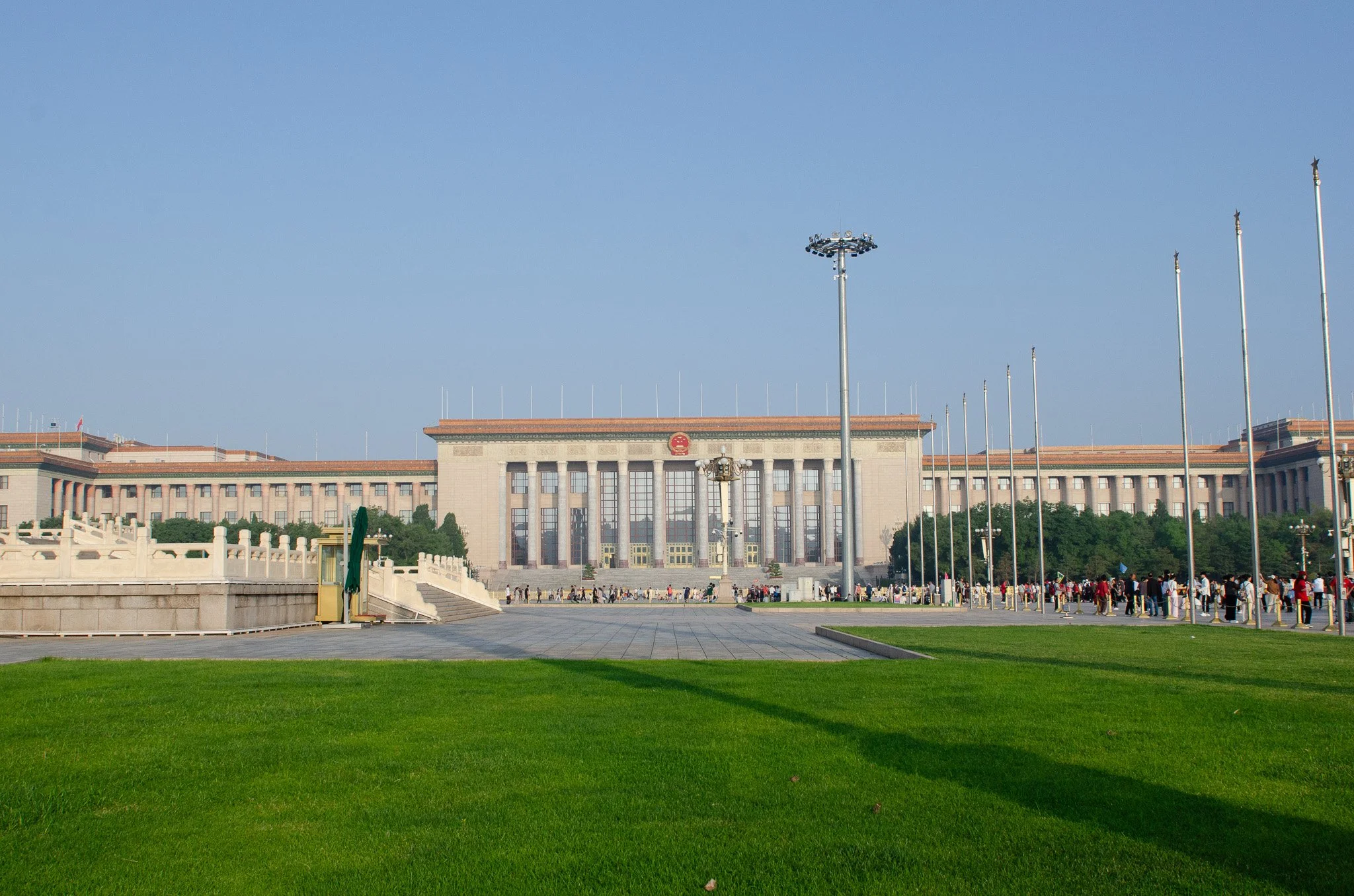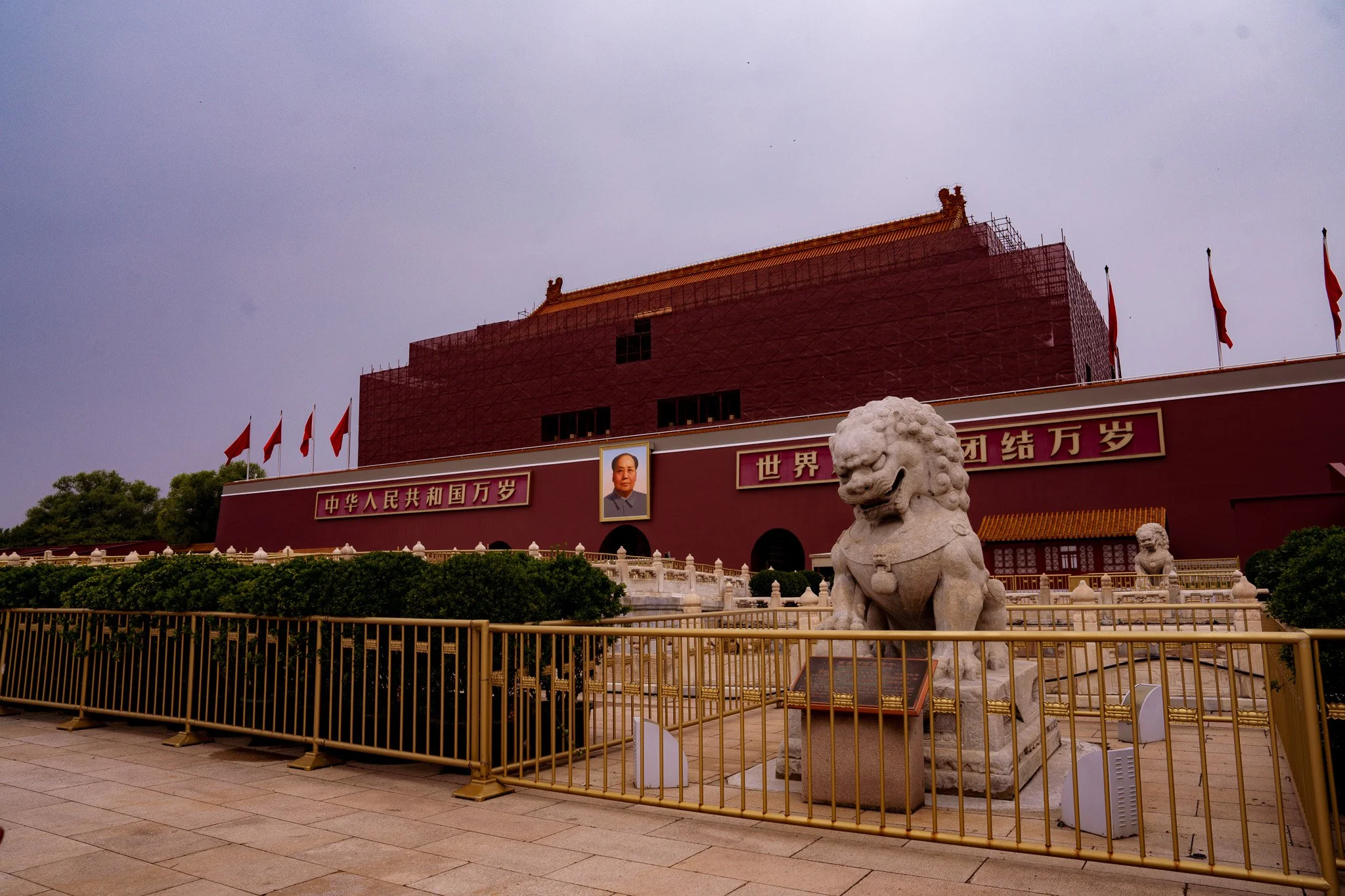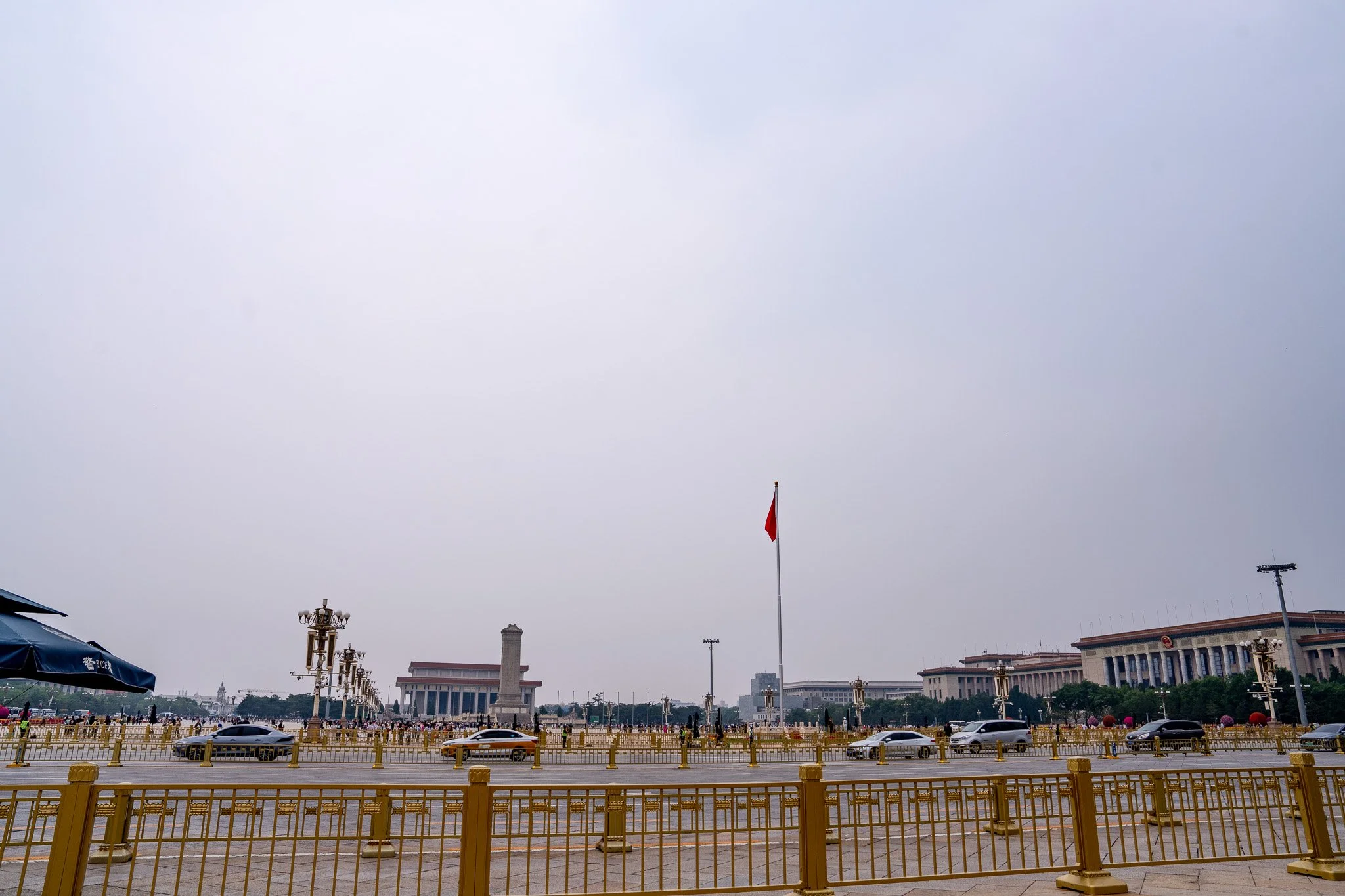China Trips - Chapter 2 - Tiananmen Square
When in Beijing, one iconic place that should not be missed is Tiananmen Square. Because of what happened there—and its long and layered history—it has become one of the most well-known public spaces in the world. Naturally, it was high on my list of places to visit. Since it’s a public square, I assumed I could simply wander in, as I would in any city square elsewhere in the world. I was so wrong.
I had planned to visit Tiananmen Square the morning after I arrived in Beijing. I’d read about the flag-raising ceremony, which in June takes place just before 5 a.m., but I didn’t realise just how popular it was. I wasn’t particularly interested in seeing the ceremony myself, so I figured by 6:30 a.m. the square would be quieter and easier to access. It was only a 30-minute walk from my hotel, and the route seemed straightforward.
When my alarm rang the next morning, I was still tired and a little groggy, but the excitement of exploring somewhere new quickly took over. I got dressed and headed out as soon as I was ready.
The morning air was crisp—cool enough to feel it on my skin, but still comfortable in just a T-shirt.
The route to Tiananmen took me past the famous Wangfujing Street, lined with shops on either side. At that early hour, only the occasional ringing of bicycle bells broke the morning stillness. I would return to this street a number of times during my stay, but this first encounter felt quietly magical.
At the end of the street, I turned right onto a wide, two-way road that was still mostly empty. The buildings lining it were a mix of hotels and government offices. As I walked, I paused in front of a few, watching the guards stationed outside. They stood perfectly upright—motionless, composed, and sharply alert—scanning their surroundings with only their eyes. At regular intervals, they would cross to the other side in a perfectly timed routine, each movement as precise and measured as the last. Even without an audience, their discipline never wavered. During a change of guard, the choreography of their steps and salutes was so exact it looked like it had been rehearsed a thousand times. Perhaps it had.
It was fascinating to watch—orderly, dignified, and quietly powerful.
Further along, I came to a stretch of the walkway where temporary steel barricades had been set up. They split the footpath into two narrow lanes: one for people entering, the other for those leaving.
As I entered the barricaded path, I had to slow down—there was a crowd ahead of me, and we moved in a slow, inching procession. I was puzzled. What was this line for? Was it just for locals? Where would it lead me? And what was waiting at the end? The uncertainty made me nervous, but I had no real choice. This was the only route forward. Even if I crossed the road, I’d have ended up in a similar setup.
Eventually, the first checkpoint came into view. Everyone around me was Chinese and began pulling out their national ID cards to scan at the gate. I was the only one holding a passport. There didn’t appear to be a scanner for it, and for a moment, my anxiety spiked—was I in the wrong queue? Would I be turned back?
But I couldn’t back out now, so I simply kept moving forward.
When I reached the officer, he took my passport, studied it briefly, then looked at my face. After a moment, he gave a small nod and waved me through.
Relief flooded over me. I thought that was it.
But the line continued, growing tighter—shoulder to shoulder now—while the lane for people leaving stood completely empty. Progress was slow, and I started to feel disoriented. How much farther did I need to walk to reach the square? I couldn’t see anything that resembled the vast open space I’d seen in photos or on television. Just more barricades, more people, more waiting.
Then came the second checkpoint.
Again, everyone around me scanned their national ID cards with practiced ease. I handed over my passport to the guard. This time, he studied it more carefully, flipping through the pages and lingering longer than the officer at the first checkpoint. His brow furrowed slightly. He seemed unsure of what to do.
After a moment, he turned and spoke to a nearby colleague who appeared to be his senior. They exchanged a few words in Chinese, and then the senior officer gave a small nod. The guard handed my passport back and gestured for me to pass.
Another wave of relief—tempered this time by lingering uncertainty.
I kept walking, following the crowd. Even though I’d already passed two checkpoints, I was still unsure if I was on the right path—especially with no sign yet of the square itself.
Then came another checkpoint—the final one, as it turned out. This time, the officers inspected my passport even more thoroughly, flipping through multiple pages and scrutinising the details. My backpack was sent through an X-ray scanner, just like every other bag. There were no exceptions.
It was all very methodical and serious, yet surprisingly efficient given the size of the crowd. The process moved steadily, almost like a well-oiled machine—quiet, orderly, and unyielding.
I came back two weeks later with my daughter—she wanted to see Tiananmen Square for herself.
We were dropped off at an unfamiliar location, though I could tell we were close. The entire area was heavily barricaded, just as I remembered. For nearly an hour, we found ourselves—quite literally—running in circles, trying to figure out how to cross the road and join the queue on the other side. Every path seemed blocked or redirected. In the end, we had to walk even farther away from the Square before finally locating a pedestrian crossing that allowed us through.
Once we were in the queue, the routine felt familiar. We moved through the same series of checkpoints. By now, it all felt strangely routine—almost like I’d done it a dozen times before.
But at the final checkpoint, the guard stopped me. He spoke to me in Chinese, and I didn’t understand a word. Seeing my confusion, he pulled out his mobile phone, typed something, and held up the screen to show me the translation.
He was asking to see a reservation.
I was stunned. A reservation? Just two weeks earlier, I’d walked in without anyone mentioning such a thing.
I typed back to ask what reservation he meant—and how I was supposed to get it.
He replied that visitors now had to reserve a spot through the WeChat app, and the booking had to be made at least a day in advance.
Not wanting to argue or hold up the line, I simply thanked him. He nodded politely and pointed us toward the exit.
We had no choice but to turn back—disappointed, especially since the Square was just beyond the small building in front of us. But at least now we knew the process for next time.
The next time came the following year, during our return trip to China. After the lesson learned from being turned away previously, I was determined to secure a reservation for Tiananmen Square well in advance—this time through WeChat.
But making that reservation was anything but easy.
I wasn’t familiar with the more advanced features of WeChat. Until then, I’d only ever used it for basic messaging. Navigating to the right mini-program felt like stumbling through a maze. Fortunately, one of my colleagues, who was well-versed in the app, stepped in to help.
The reservation form looked straightforward at first—just the usual fields for personal details. But when I entered my mobile number, the form kept rejecting it, flashing the same frustrating message: Invalid number. I tried every combination I could think of—country code, no country code, different spacing—but nothing worked.
Once again, my colleague came to the rescue. He offered to use his Chinese mobile number instead. It worked instantly.
Then came the next hurdle: selecting my nationality. Naturally, I typed “Australian”—but the system couldn’t find it in its preprogramed list. I retyped it, tried different variations. Still nothing.
My colleague stepped in again. He typed “Australian” in Chinese characters, copied it into the form, and just like that, the field accepted it.
From there, everything went smoothly. I received a confirmation for the reservation, and it appeared in my WeChat app—or so I thought.
After passing through the final checkpoint, I stepped into what I began to call the “free zone.” For the first time since entering the complex, I could move without restriction. The area was still divided by barricades and wide roads, but a network of controlled crossings and underground tunnels stitched these fragmented pockets into one expansive space—with Tiananmen Square at its centre.
There were a lot of people. Many held small Chinese flags, likely remnants from the early morning flag-raising ceremony. The energy was vibrant but steady—something heartfelt lingered in the air, as if they’d just witnessed something deeply moving. I thought to myself, I should’ve come earlier to see that.
Ahead, across the street, Tiananmen Square stretched out before me—a colossal expanse I’d seen in countless photographs, but never imagined could feel so vast, so monumental. I joined the quiet current of people moving toward the designated crossing—strangers who, like me, seemed momentarily hushed by the scale of it all.
Once we reached the other side, the square unfurled around us in every direction. It was an enormous plain of pale paving stones, dotted with monuments, low gardens, and imposing buildings that seemed to dwarf even the largest tour groups. At the far end rose the Tiananmen Gate, the massive portrait of Mao Zedong gazing out over the square with an air of solemn permanence. Not far from the gate stood the tall flagpole I’d read about—the site of the daily flag-raising and lowering ceremonies that draw thousands of spectators.
I began to walk slowly, trying to take it all in. Every few steps, I passed families posing for photos, groups gathered around guides waving brightly coloured flags, and lone visitors standing in quiet reflection. Yet the square was so vast that in some corners—especially on the far side opposite the Gate—I found entire stretches where I stood alone, my footsteps echoing faintly across the open stone.
Eventually, I reached the Mao Zedong Memorial Hall at the far southern end. It stood behind its own barrier—sober, solemn—the place where Mao’s body still lies on display. Entry into the surrounding buildings required tickets. I hadn’t planned to visit any of them, so I simply observed from the outside.
For more than two hours, I wandered from one end of the square to the other, crossing open expanses that seemed to swallow the sound of the crowd. From time to time, I paused to study the monuments or just stand still, trying to absorb the weight of history that lingered in the air. And as I walked, I kept wondering—then and even now—about the heavy security. What exactly were they trying to protect? Or prevent? Maybe it was simply about managing the flow of people. No matter how massive the square was, it could easily become dangerously overcrowded.
Eventually, with tired legs and a camera full of photos, I began making my way toward the exit. After all the controlled passages and checkpoints that had brought me in, leaving was surprisingly simple—almost as if the square had let me slip quietly back into the city beyond.
We were determined to visit Tiananmen Square again on our return trip to China the following year, so my daughter could finally see it for herself. I thought I had secured the reservation through WeChat. While waiting to board our flight, I decided to double-check—just to make sure the booking was still in the app. We planned to visit the square the morning after landing in Beijing.
To my horror, I couldn’t find it.
I spent nearly an hour searching every corner of WeChat, but the reservation was nowhere to be found. Where could it have gone?
I tried to make a new booking, but the system rejected my attempt, telling me I already had a reservation.
A sinking feeling settled in. Why was it so hard to visit this place? It was starting to feel like the universe was determined to stop my daughter from ever setting foot on the square.
I knew there was another option—booking through a tour agency for a small fee—but I kept that as my last resort.
I texted my friend, the same colleague who had helped with the booking before, and asked if he could check his phone. Since we had used his Chinese mobile number for the registration, maybe the reservation was linked to his account instead.
Sure enough, the reservation was there—on his phone.
I was confused. I was almost certain I’d seen the confirmation appear on mine the day we made the booking. But at that point, it didn’t matter. He took a screenshot and sent it to me.
Would a screenshot be accepted at the gate? I wasn’t sure. But after all the twists and turns, I was willing to take the risk.
The next morning, we set out on our mission.
This time, we were staying at a different hotel, one even closer to the square. Instead of the main boulevard, we walked along a narrow two-way street lined with souvenir stalls and street food vendors. The street was already bustling. Then again, everywhere in Beijing seemed to be bustling—and by now, we had grown used to it.
We entered the familiar barricaded path and joined the queue. Just like before, we passed through the three security checkpoints.
At the first, an officer checked our passports and waved us through.
At the second checkpoint, the guard asked for our reservation. This was the moment I’d been dreading. I pulled out the screenshot on my phone and showed it to him. He studied it, checked our passport details, paused for a moment—and then waved us on.
I couldn’t help but smile, though I kept it to myself. I knew there was still one more hurdle ahead, and there was always the chance we could be turned away at the final gate.
At the third and final checkpoint, they didn’t ask about the reservation at all. Instead, they simply took our passports—I wasn’t entirely sure why—and scanned our bags. A few guards stood at the end of the inspection area, and one of them handed our passports back with a polite nod.
It struck me how, in all three visits to Tiananmen Square, I’d gone through the same sequence of checkpoints—yet each time, the experience had been slightly different. The process never changed, but the people, the mood, and the subtle details made each visit feel unique.
Once we stepped out of the bag-scanning building, we let out a big sigh of relief. After all the ordeals, we had finally made it. It genuinely felt like we had accomplished something.
Ahead of us stood the Tiananmen Gate, rising quietly and unmistakably. We walked forward for a closer look at the iconic building. This time, I felt surprisingly confident navigating the square—I had spent nearly two hours here during my last visit. Now I stepped into the role of tour guide, pointing things out to my daughter as we explored.
There weren’t as many people as the year before, which gave us a few rare, quiet moments to wander and absorb the atmosphere.
We didn’t stay too long—this visit was more about closure. It was about finally being able to say, “I was here.”
We had a packed itinerary ahead. A train to Jinan awaited us after midday, and there was one more place we wanted to visit—something we’d missed last year and didn’t want to skip again.














